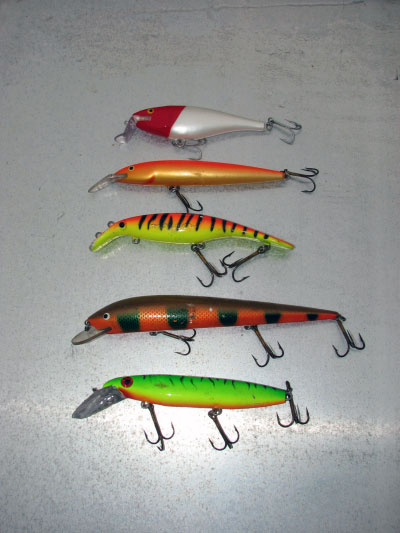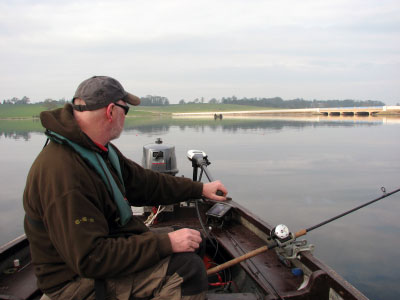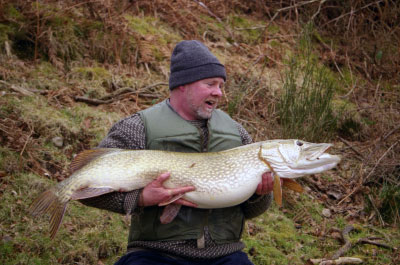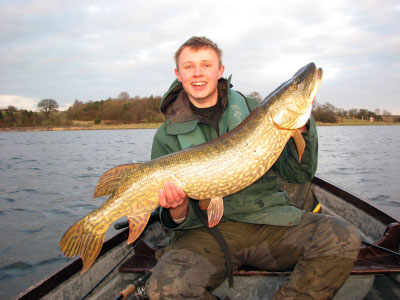Trolling
Trolling is a huge subject, far too big to be covered in depth here, but I will attempt to go through the basics and leave the reader to find the many “wrinkles” for himself.
It is a method which many people tend to use if they are fishing a water for the first time. This is with good reason as there is no better way of covering water quickly and searching out the fish holding areas. Clearly we are talking about catching predatory fish here and I have caught catfish, pike, perch, chub, brown trout and rainbow trout on trolled lures but the thrust of this piece will be on fishing for pike.
I will divide this section into two, dealing with trolling with lures and baits.
Trolling Lures
Compared to many American anglers, most people in the UK are novices to this method of fishing and it is no surprise then that it is to the US that many of us turn to find new tackle and techniques. The range of lures available is breathtaking and it is fair to say that the real difficulty is in making the right choice: but how to go about it?
When selecting lures, think about what different qualities a lure has and how this will suit the waters you intend to fish. It is tempting to choose your lures according to their colour or their action, and I know many people who do this, but these two facets come fairly low down on my list of important qualities. First and foremost comes running depth. You should have a lure selection which covers all depths from the surface to at least 20 feet. Examples of shallow running lures would be the lucky 13 and “bomber long A” which will go down to six feet or so. The Super Shad Rap is an excellent midwater lure on which I have caught a great many fish and it will run down to ten feet. “Believers” will run a little deeper than this, as will Grandma and Jake lures, and then there is a wide selection of big-lipped lures like the deep thunder or ernie which will run at twenty feet or more. Experienced lure fishermen should know that a diving plug will generally dive quite a bit deeper on the troll than it does when casting and retrieving and the experience of trolling while using a sounder will soon give the angler all the information he needs about which lure will run at what depth. It’s easy enough, just watch the sounder and note the depth at which your lure starts to bump bottom.
 |
|
A selection of crankbaits used for trolling |
Lure size is an important consideration. Don’t be afraid to use large lures – remember you wont be casting them very often and a big lure will often attract more and bigger fish. Seven inch lures will frequently be wolfed by two pound jacks so there is no need to fear a big lure will put the fish off. I regularly use lures of between eight and ten inches but at times, I also use fairly small ones. I caught one of my largest pike on a very small lure so, as in the case of running depth, it pays to have a good range.
Stability is next on my list of priorities. This is a function which the “cast and retrieve” lure fisherman might not consider at all yet it is very important in trolling. Well-designed lures will run true even at quite high speeds while some of the cheaper lures will start to roll or kick over as the trolling speed increases. I cannot fault the excellent Rapala Magnum series in this respect and find this lure a potent fish catcher.
Only now, fairly well down the list, do I start to consider such things as action and colour (in that order I might add). Pike are really not the brightest of fish and on the whole, I do believe that most lures will be taken by a hungry pike if they are properly presented. This is especially true when trolling at speed, when the poor old pike is faced with a quick decision over whether to grab its prey there and then or allow it to escape. Forty million years of evolution are on the anglers side here and more often than not the pikes conditioning gets the better of it and a strike occurs.
Depth
Several things will influence the depth at which your lure will run. Lure choice as described above is the most obvious but the others can be used to the anglers advantage. The distance at which the lure is fished will have an impact and generally, the further behind the boat the lure is fished, the deeper it will run. There is a limit to this however and for mid-running lures there is very little to be gained depth-wise from fishing them more than thirty yards behind the boat. It might be that fishing lures further back will result in a more confident strike (because there is less disturbance from the boat) but I am yet to be convinced of this. Indeed I know people who prefer to fish their lures very short, sometimes right in the prop-wash and they still catch fish.
For a number of reasons it is often sensible to fish the lure on as short a line as possible while still maintaining adequate depth. Keeping little line in the water will give the angler more control over the lure and prevent the need for frequent lure changes as the depth of the water changes. For instance, while running over water that is, say, fourteen feet deep, a lure which has a running depth of ten feet would probably be a good choice. However, the angler might be chugging along watching the sounder and suddenly see that there is an underwater obstruction which rises up five or six feet off the bottom. Clearly there is a risk of a snag-up here but there is also a chance that a fish or two are hiding close to the snag. What is needed is for the lure to rise up so that it just clears the obstruction. This is easily achieved by lifting the rod tip well clear of the surface of the water but it is only really effective if the lure is being fished the correct distance behind the boat. Fish it too far back and the effect of lifting the rod is lessened or even eliminated altogether.
 |
|
Float trolling deadbaits on a calm day. |
Keeping the amount of line in the water to a minimum also helps if turning the boat when following a contour or skirting a bank side feature. Too much line between boat and lure makes it impossible to follow features tightly and the lure ends up in a “middle of the road” kind of run well away from where the fish are.
On occasions it makes sense to fish a lure very short, say just ten yards back. This might be when the general depth calls for a lure which runs quite deep but there are areas which you want to cover which are much shallower. Reeling in twenty yards of line will reduce the running depth of the lure significantly and enable this shallower water to be covered without the interruption of changing the lure.
Losing lures
Modern lures are expensive, it’s true, but it is a mistake to allow this to prevent you from using them amongst snags. You won’t lose many lures if you’re fishing from a boat since the ability to get right over the top of the snag or behind it gives the edge in retrieving them. You will still lose the odd one but if you don’t get snagged up from time to time then you’re not using your lures in the right place anyway.
Trolling baits
Trolling baits, whether live or dead, is another deadly method, possibly even more effective than trolling lures on its day, and again it’s a very big subject which I can’t hope to cover adequately here. This is a method I would use late in the season when the water is cold and the fishing can be quite hard. Lure fishing is less productive at this time of year but the fish will still respond well to a slowly fished bait.
There are a variety of methods employed to fish a deadbait on the troll, some involving the use of a float and some not. My preference is to fish with a trolling float and a fairly heavy lead but I have found the dedicated trolling floats such as those made by Fox to be inferior. These floats have a clever integral line-locking device which prevents the float from working down the line as the bait is being trolled but if you use a good heavy lead, it isn’t actually necessary. I use large sea fishing floats for my trolling these days and coupled with a three ounce lead the bait will stay down where you want it and the line won’t pull through the float on the troll. Don’t worry if the float seems to sit very low in the water with this weight, the action of trolling will tend to make it sit up more in the water and it will still be very visible.
 |
|
A 32lb plus pike taken on a trolled deadbait |
The fishing depth is set using the usual stop knot and bead, after which the float is threaded on and the trace attached. I like to use a ball bearing swivel at the top of the trace since the bait is likely to spin as it is being fished and the swivel will help eliminate line twist. Attaching the lead to the top eye of the swivel by means of a small clip further ensures that there will be no twist.
The traces I use are a little different from normal deadbaiting traces. The hooks are quite a bit bigger for a start, being up to a size 2/0. I also use a short extension piece which consists of a piece of trace wire some eight inches long with a sturdy clip at one end and a treble at the other. This is clipped to the eye of the top treble on the main trace and when in use, this hook is stuck into the bait close to the tail. I therefore have three fairly large hooks in my bait, one at the head, one halfway along the bait on its flank and another down the other flank close to the tail. The idea behind this is that I can strike instantly when I get a take and usually hook my fish. Thus I don’t have to worry about a pike dropping the bait or exactly when to strike, bearing in mind that the bait is to be mounted head up the trace and a quickly turned bait could result in a deep hooked pike if the strike is at all delayed.
On a calm day, this rig can be used to great effect just by trolling it slowly on the oars. Trolling with oars becomes rather more difficult if there is a wind on the water however and in some cases, nigh on impossible. This is where a good quality electric outboard comes into its own. It really isn’t possible to troll a deadbait using a petrol outboard, they just can’t tick over slowly enough. Indeed it’s also important to choose your electric with care since some of them are too powerful to troll from a light boat even on their lowest setting. Without doubt, the best type of electric motor is one with an infinitely variable speed control. This will enable baits to be towed along ever-so-slowly but when the wind gets up and some power is needed, a simple flick of the wrist is all that’s needed to keep the speed constant. I would recommend that you buy the largest electric motor your budget will stand since this will enable you to use it as your main engine and prevent the need to keep swapping over from petrol to electric depending on whether you are trolling or just moving about. The Minn Kota Maxxum range is just about unbeatable in my view but they are rather pricey.
A typical days trolling will see me chop and change between lures and baits. When I’m out on the river I generally troll upstream with lures since this enables me to travel faster and then back down again with baits, the motor just keeping me ahead of the current.
Fishing on the Drift
If trolling enables you to seek out those fish-holding areas, fishing from a drifting boat will enable you to really get the best from them. Deadbaits and livebaits can be fished from a drifting boat fairly easily using a standard floatfishing rig. The bait will travel behind the boat since it is less affected by the wind and if you wish, it is a simple matter to cast and retrieve a lure at the same time as fishing the bait. Slowly working across a plateau or along a shoreline in such a manner will enable you to cover the area thoroughly and give you the best possible chance of picking up any feeding fish.
 |
|
My son Joe with a fine 28lb 9oz taken on a slow trolled mackerel. |
Drifting free like this is ok in a gentle breeze but if the wind is a little stronger, a drogue may be needed. This is basically an underwater parachute which fills with water and slows the boat down. They are available from The Tackle Shop at Gainsborough among other places and aren’t too expensive. There are some alternatives to buying one however. I have a very large weighing sling which I tend to use and which will slow me down adequately in a steady wind and I did hear of an angler who uses a sheet, fastened to the gunwale at two corners and weighted down at the other two. I can see that this latter method has the advantage of having little to snag up on should a fish be hooked.
If you have an electric outboard available, this too can be used to slow down a drift. This is particularly useful on a river where the floatfished baits have a habit of catching up with the boat. It can also be used to control the direction of drift if the line you are following is not quite what you want. In fact the more I use my electric motor, the more I find uses for it: I cannot recommend one highly enough!
Well, that’s the end of this series on boat fishing. I hope you’ve enjoyed reading it as much as I’ve enjoyed writing it and I hope its at least whetted the appetite of a few people enough to get them to give it a go.
If you want to contact me over this, or any other fishing matter that I might he able to help with, then e-mail me at: Eric_Edwards@msn.com.
Good fishing
Eric Edwards
Postscript
This series of articles was originally written for another website around ten years ago. I’ve updated it a little to reflect changes in techniques and in my own preferences but the basics remain the same. I’ve stuck some more modern pictures in too, ol’ Maynard lost the others!










